Challenges in Global Supply Chain and Logistics
VerifiedAdded on 2023/01/18
|15
|4157
|30
AI Summary
This study explores the challenges faced in global supply chain and logistics, including economic, distribution, manufacturing, supply, political, and organizational challenges. It also discusses the methods of implementing successful global supply chains and provides valuable insights for supply chain management strategies.
Contribute Materials
Your contribution can guide someone’s learning journey. Share your
documents today.

SUPPLY CHAIN AND LOGISTICS 1
CHALLENGES IN GLOBAL SUPPLY CHAIN AND LOGISTICS
Name of student
Name of institution
Name of instructor
Course code
Date
CHALLENGES IN GLOBAL SUPPLY CHAIN AND LOGISTICS
Name of student
Name of institution
Name of instructor
Course code
Date
Secure Best Marks with AI Grader
Need help grading? Try our AI Grader for instant feedback on your assignments.
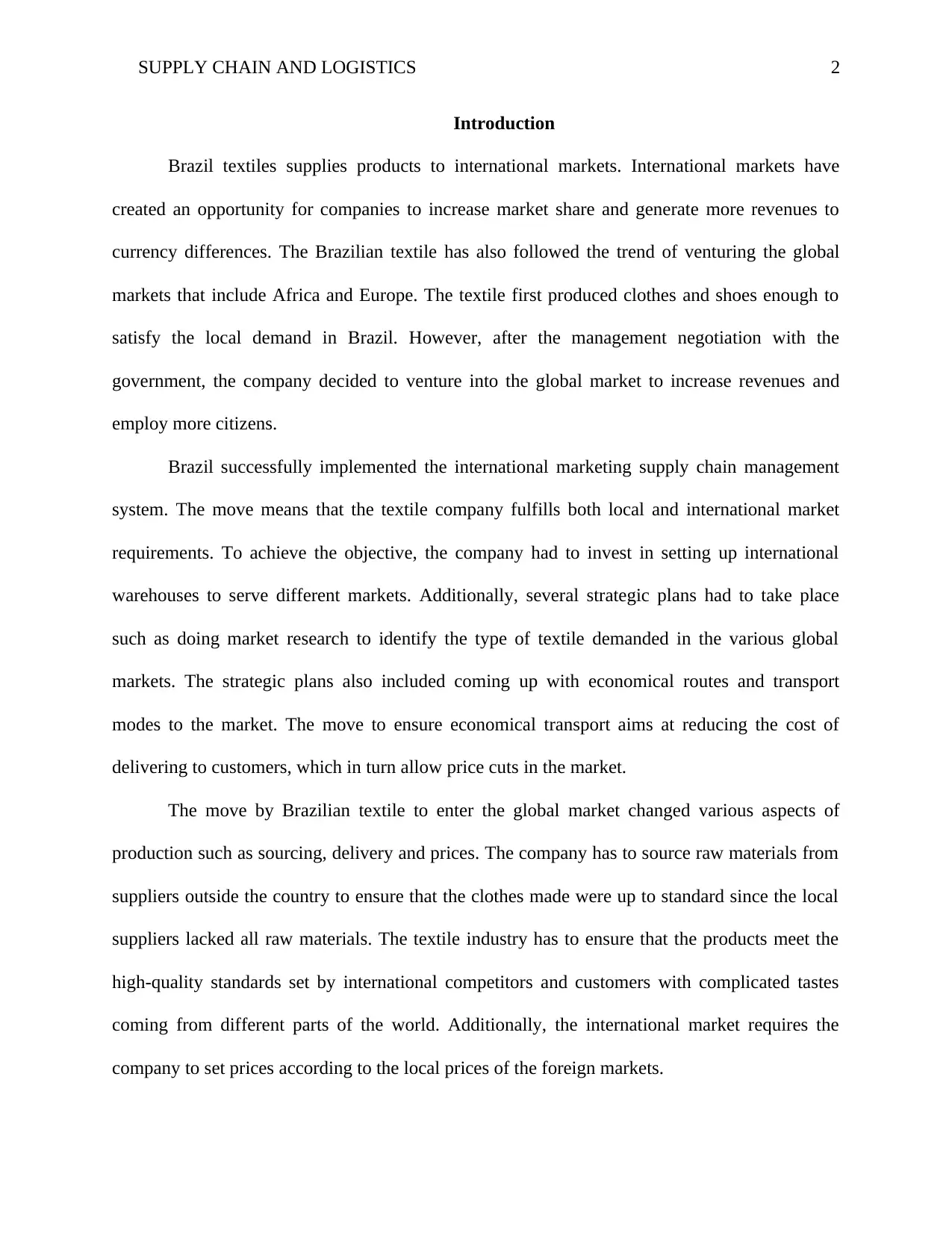
SUPPLY CHAIN AND LOGISTICS 2
Introduction
Brazil textiles supplies products to international markets. International markets have
created an opportunity for companies to increase market share and generate more revenues to
currency differences. The Brazilian textile has also followed the trend of venturing the global
markets that include Africa and Europe. The textile first produced clothes and shoes enough to
satisfy the local demand in Brazil. However, after the management negotiation with the
government, the company decided to venture into the global market to increase revenues and
employ more citizens.
Brazil successfully implemented the international marketing supply chain management
system. The move means that the textile company fulfills both local and international market
requirements. To achieve the objective, the company had to invest in setting up international
warehouses to serve different markets. Additionally, several strategic plans had to take place
such as doing market research to identify the type of textile demanded in the various global
markets. The strategic plans also included coming up with economical routes and transport
modes to the market. The move to ensure economical transport aims at reducing the cost of
delivering to customers, which in turn allow price cuts in the market.
The move by Brazilian textile to enter the global market changed various aspects of
production such as sourcing, delivery and prices. The company has to source raw materials from
suppliers outside the country to ensure that the clothes made were up to standard since the local
suppliers lacked all raw materials. The textile industry has to ensure that the products meet the
high-quality standards set by international competitors and customers with complicated tastes
coming from different parts of the world. Additionally, the international market requires the
company to set prices according to the local prices of the foreign markets.
Introduction
Brazil textiles supplies products to international markets. International markets have
created an opportunity for companies to increase market share and generate more revenues to
currency differences. The Brazilian textile has also followed the trend of venturing the global
markets that include Africa and Europe. The textile first produced clothes and shoes enough to
satisfy the local demand in Brazil. However, after the management negotiation with the
government, the company decided to venture into the global market to increase revenues and
employ more citizens.
Brazil successfully implemented the international marketing supply chain management
system. The move means that the textile company fulfills both local and international market
requirements. To achieve the objective, the company had to invest in setting up international
warehouses to serve different markets. Additionally, several strategic plans had to take place
such as doing market research to identify the type of textile demanded in the various global
markets. The strategic plans also included coming up with economical routes and transport
modes to the market. The move to ensure economical transport aims at reducing the cost of
delivering to customers, which in turn allow price cuts in the market.
The move by Brazilian textile to enter the global market changed various aspects of
production such as sourcing, delivery and prices. The company has to source raw materials from
suppliers outside the country to ensure that the clothes made were up to standard since the local
suppliers lacked all raw materials. The textile industry has to ensure that the products meet the
high-quality standards set by international competitors and customers with complicated tastes
coming from different parts of the world. Additionally, the international market requires the
company to set prices according to the local prices of the foreign markets.
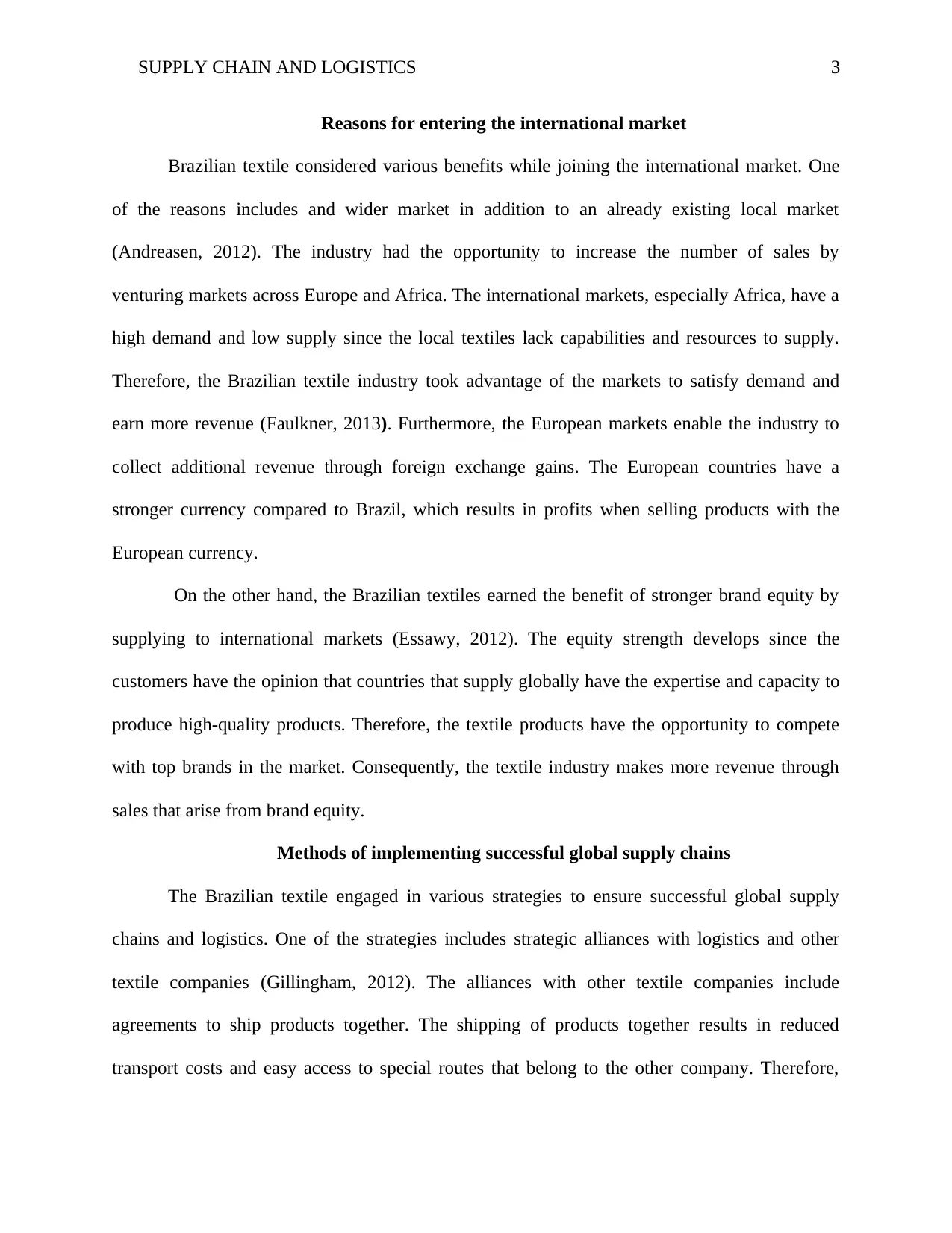
SUPPLY CHAIN AND LOGISTICS 3
Reasons for entering the international market
Brazilian textile considered various benefits while joining the international market. One
of the reasons includes and wider market in addition to an already existing local market
(Andreasen, 2012). The industry had the opportunity to increase the number of sales by
venturing markets across Europe and Africa. The international markets, especially Africa, have a
high demand and low supply since the local textiles lack capabilities and resources to supply.
Therefore, the Brazilian textile industry took advantage of the markets to satisfy demand and
earn more revenue (Faulkner, 2013). Furthermore, the European markets enable the industry to
collect additional revenue through foreign exchange gains. The European countries have a
stronger currency compared to Brazil, which results in profits when selling products with the
European currency.
On the other hand, the Brazilian textiles earned the benefit of stronger brand equity by
supplying to international markets (Essawy, 2012). The equity strength develops since the
customers have the opinion that countries that supply globally have the expertise and capacity to
produce high-quality products. Therefore, the textile products have the opportunity to compete
with top brands in the market. Consequently, the textile industry makes more revenue through
sales that arise from brand equity.
Methods of implementing successful global supply chains
The Brazilian textile engaged in various strategies to ensure successful global supply
chains and logistics. One of the strategies includes strategic alliances with logistics and other
textile companies (Gillingham, 2012). The alliances with other textile companies include
agreements to ship products together. The shipping of products together results in reduced
transport costs and easy access to special routes that belong to the other company. Therefore,
Reasons for entering the international market
Brazilian textile considered various benefits while joining the international market. One
of the reasons includes and wider market in addition to an already existing local market
(Andreasen, 2012). The industry had the opportunity to increase the number of sales by
venturing markets across Europe and Africa. The international markets, especially Africa, have a
high demand and low supply since the local textiles lack capabilities and resources to supply.
Therefore, the Brazilian textile industry took advantage of the markets to satisfy demand and
earn more revenue (Faulkner, 2013). Furthermore, the European markets enable the industry to
collect additional revenue through foreign exchange gains. The European countries have a
stronger currency compared to Brazil, which results in profits when selling products with the
European currency.
On the other hand, the Brazilian textiles earned the benefit of stronger brand equity by
supplying to international markets (Essawy, 2012). The equity strength develops since the
customers have the opinion that countries that supply globally have the expertise and capacity to
produce high-quality products. Therefore, the textile products have the opportunity to compete
with top brands in the market. Consequently, the textile industry makes more revenue through
sales that arise from brand equity.
Methods of implementing successful global supply chains
The Brazilian textile engaged in various strategies to ensure successful global supply
chains and logistics. One of the strategies includes strategic alliances with logistics and other
textile companies (Gillingham, 2012). The alliances with other textile companies include
agreements to ship products together. The shipping of products together results in reduced
transport costs and easy access to special routes that belong to the other company. Therefore,
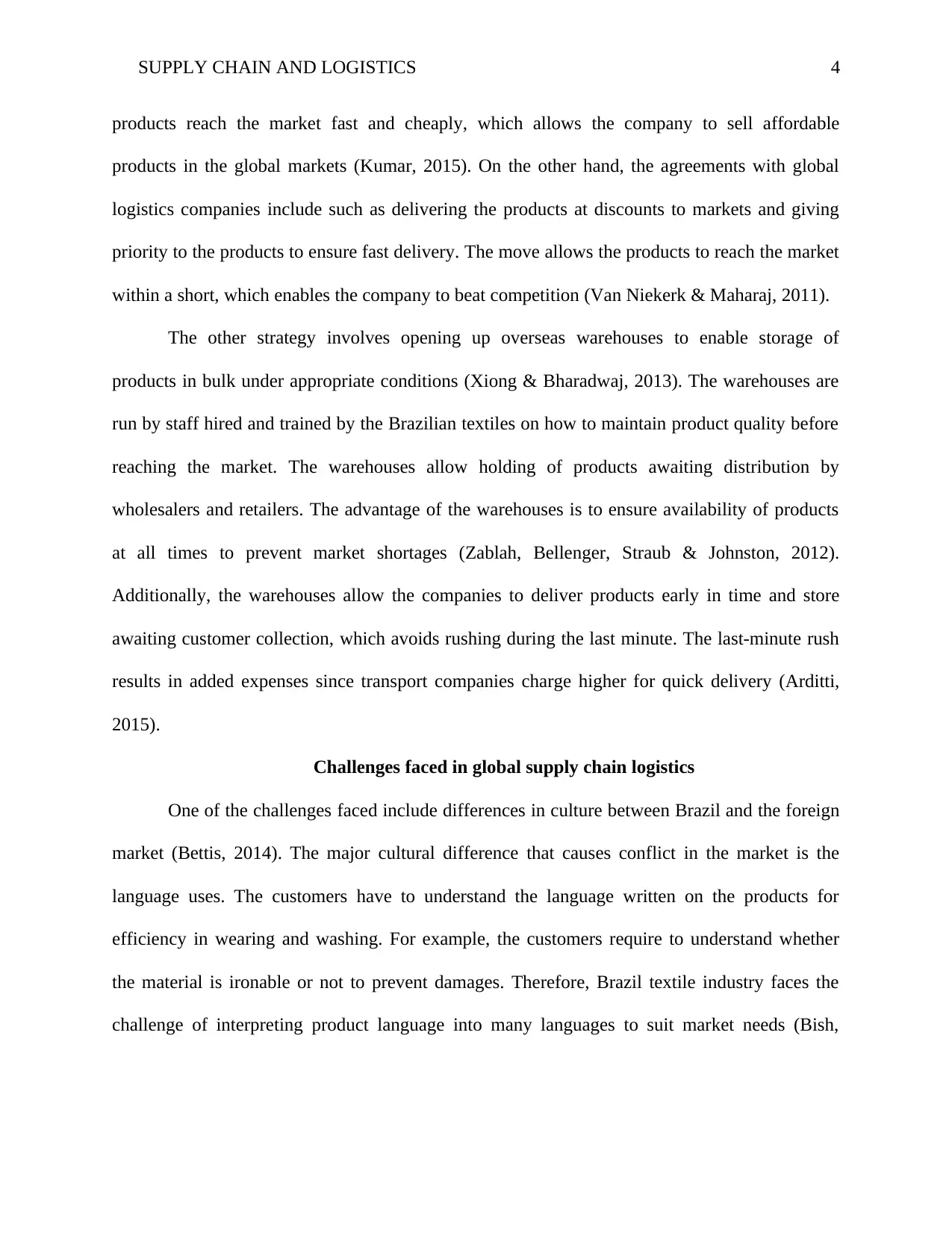
SUPPLY CHAIN AND LOGISTICS 4
products reach the market fast and cheaply, which allows the company to sell affordable
products in the global markets (Kumar, 2015). On the other hand, the agreements with global
logistics companies include such as delivering the products at discounts to markets and giving
priority to the products to ensure fast delivery. The move allows the products to reach the market
within a short, which enables the company to beat competition (Van Niekerk & Maharaj, 2011).
The other strategy involves opening up overseas warehouses to enable storage of
products in bulk under appropriate conditions (Xiong & Bharadwaj, 2013). The warehouses are
run by staff hired and trained by the Brazilian textiles on how to maintain product quality before
reaching the market. The warehouses allow holding of products awaiting distribution by
wholesalers and retailers. The advantage of the warehouses is to ensure availability of products
at all times to prevent market shortages (Zablah, Bellenger, Straub & Johnston, 2012).
Additionally, the warehouses allow the companies to deliver products early in time and store
awaiting customer collection, which avoids rushing during the last minute. The last-minute rush
results in added expenses since transport companies charge higher for quick delivery (Arditti,
2015).
Challenges faced in global supply chain logistics
One of the challenges faced include differences in culture between Brazil and the foreign
market (Bettis, 2014). The major cultural difference that causes conflict in the market is the
language uses. The customers have to understand the language written on the products for
efficiency in wearing and washing. For example, the customers require to understand whether
the material is ironable or not to prevent damages. Therefore, Brazil textile industry faces the
challenge of interpreting product language into many languages to suit market needs (Bish,
products reach the market fast and cheaply, which allows the company to sell affordable
products in the global markets (Kumar, 2015). On the other hand, the agreements with global
logistics companies include such as delivering the products at discounts to markets and giving
priority to the products to ensure fast delivery. The move allows the products to reach the market
within a short, which enables the company to beat competition (Van Niekerk & Maharaj, 2011).
The other strategy involves opening up overseas warehouses to enable storage of
products in bulk under appropriate conditions (Xiong & Bharadwaj, 2013). The warehouses are
run by staff hired and trained by the Brazilian textiles on how to maintain product quality before
reaching the market. The warehouses allow holding of products awaiting distribution by
wholesalers and retailers. The advantage of the warehouses is to ensure availability of products
at all times to prevent market shortages (Zablah, Bellenger, Straub & Johnston, 2012).
Additionally, the warehouses allow the companies to deliver products early in time and store
awaiting customer collection, which avoids rushing during the last minute. The last-minute rush
results in added expenses since transport companies charge higher for quick delivery (Arditti,
2015).
Challenges faced in global supply chain logistics
One of the challenges faced include differences in culture between Brazil and the foreign
market (Bettis, 2014). The major cultural difference that causes conflict in the market is the
language uses. The customers have to understand the language written on the products for
efficiency in wearing and washing. For example, the customers require to understand whether
the material is ironable or not to prevent damages. Therefore, Brazil textile industry faces the
challenge of interpreting product language into many languages to suit market needs (Bish,
Secure Best Marks with AI Grader
Need help grading? Try our AI Grader for instant feedback on your assignments.
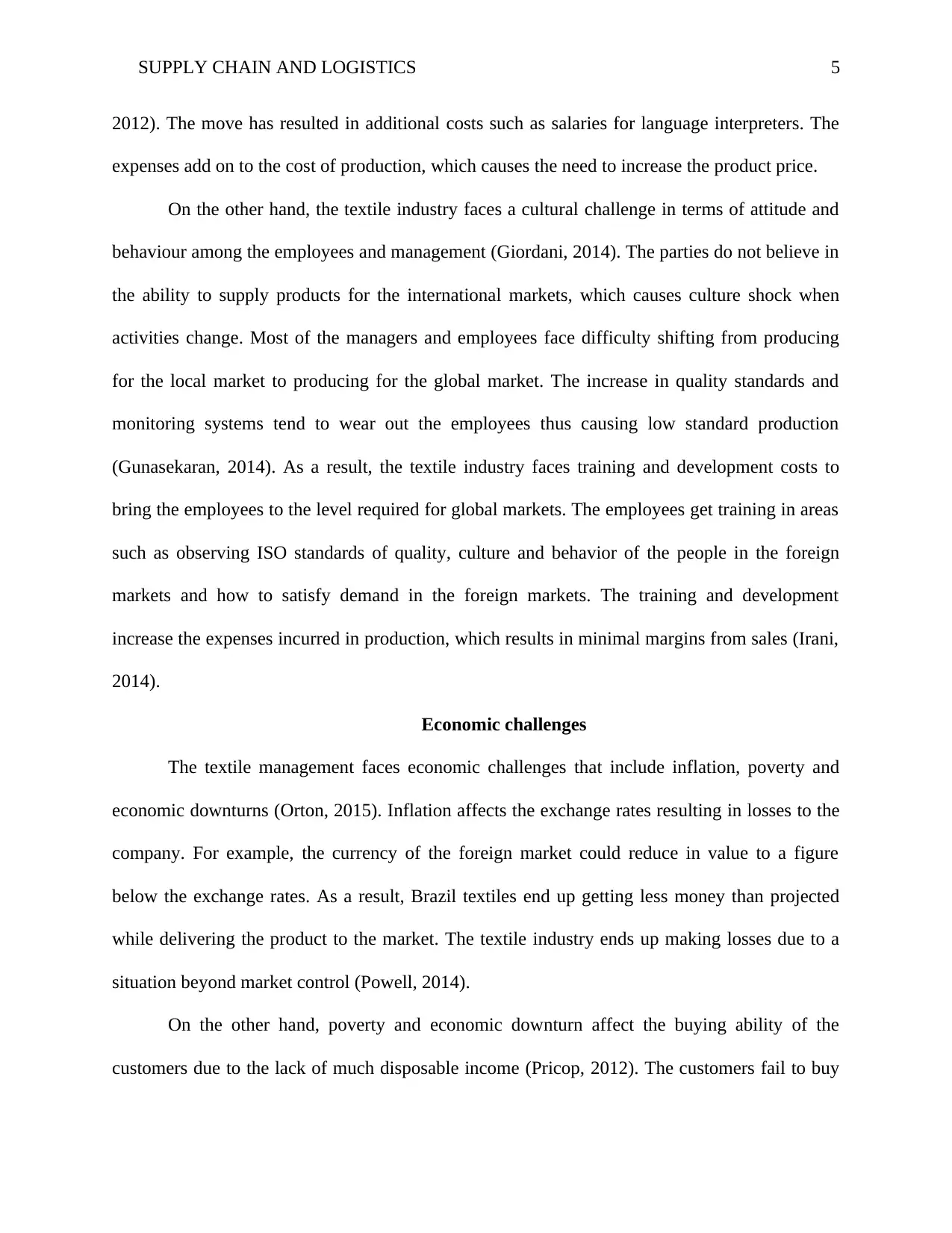
SUPPLY CHAIN AND LOGISTICS 5
2012). The move has resulted in additional costs such as salaries for language interpreters. The
expenses add on to the cost of production, which causes the need to increase the product price.
On the other hand, the textile industry faces a cultural challenge in terms of attitude and
behaviour among the employees and management (Giordani, 2014). The parties do not believe in
the ability to supply products for the international markets, which causes culture shock when
activities change. Most of the managers and employees face difficulty shifting from producing
for the local market to producing for the global market. The increase in quality standards and
monitoring systems tend to wear out the employees thus causing low standard production
(Gunasekaran, 2014). As a result, the textile industry faces training and development costs to
bring the employees to the level required for global markets. The employees get training in areas
such as observing ISO standards of quality, culture and behavior of the people in the foreign
markets and how to satisfy demand in the foreign markets. The training and development
increase the expenses incurred in production, which results in minimal margins from sales (Irani,
2014).
Economic challenges
The textile management faces economic challenges that include inflation, poverty and
economic downturns (Orton, 2015). Inflation affects the exchange rates resulting in losses to the
company. For example, the currency of the foreign market could reduce in value to a figure
below the exchange rates. As a result, Brazil textiles end up getting less money than projected
while delivering the product to the market. The textile industry ends up making losses due to a
situation beyond market control (Powell, 2014).
On the other hand, poverty and economic downturn affect the buying ability of the
customers due to the lack of much disposable income (Pricop, 2012). The customers fail to buy
2012). The move has resulted in additional costs such as salaries for language interpreters. The
expenses add on to the cost of production, which causes the need to increase the product price.
On the other hand, the textile industry faces a cultural challenge in terms of attitude and
behaviour among the employees and management (Giordani, 2014). The parties do not believe in
the ability to supply products for the international markets, which causes culture shock when
activities change. Most of the managers and employees face difficulty shifting from producing
for the local market to producing for the global market. The increase in quality standards and
monitoring systems tend to wear out the employees thus causing low standard production
(Gunasekaran, 2014). As a result, the textile industry faces training and development costs to
bring the employees to the level required for global markets. The employees get training in areas
such as observing ISO standards of quality, culture and behavior of the people in the foreign
markets and how to satisfy demand in the foreign markets. The training and development
increase the expenses incurred in production, which results in minimal margins from sales (Irani,
2014).
Economic challenges
The textile management faces economic challenges that include inflation, poverty and
economic downturns (Orton, 2015). Inflation affects the exchange rates resulting in losses to the
company. For example, the currency of the foreign market could reduce in value to a figure
below the exchange rates. As a result, Brazil textiles end up getting less money than projected
while delivering the product to the market. The textile industry ends up making losses due to a
situation beyond market control (Powell, 2014).
On the other hand, poverty and economic downturn affect the buying ability of the
customers due to the lack of much disposable income (Pricop, 2012). The customers fail to buy
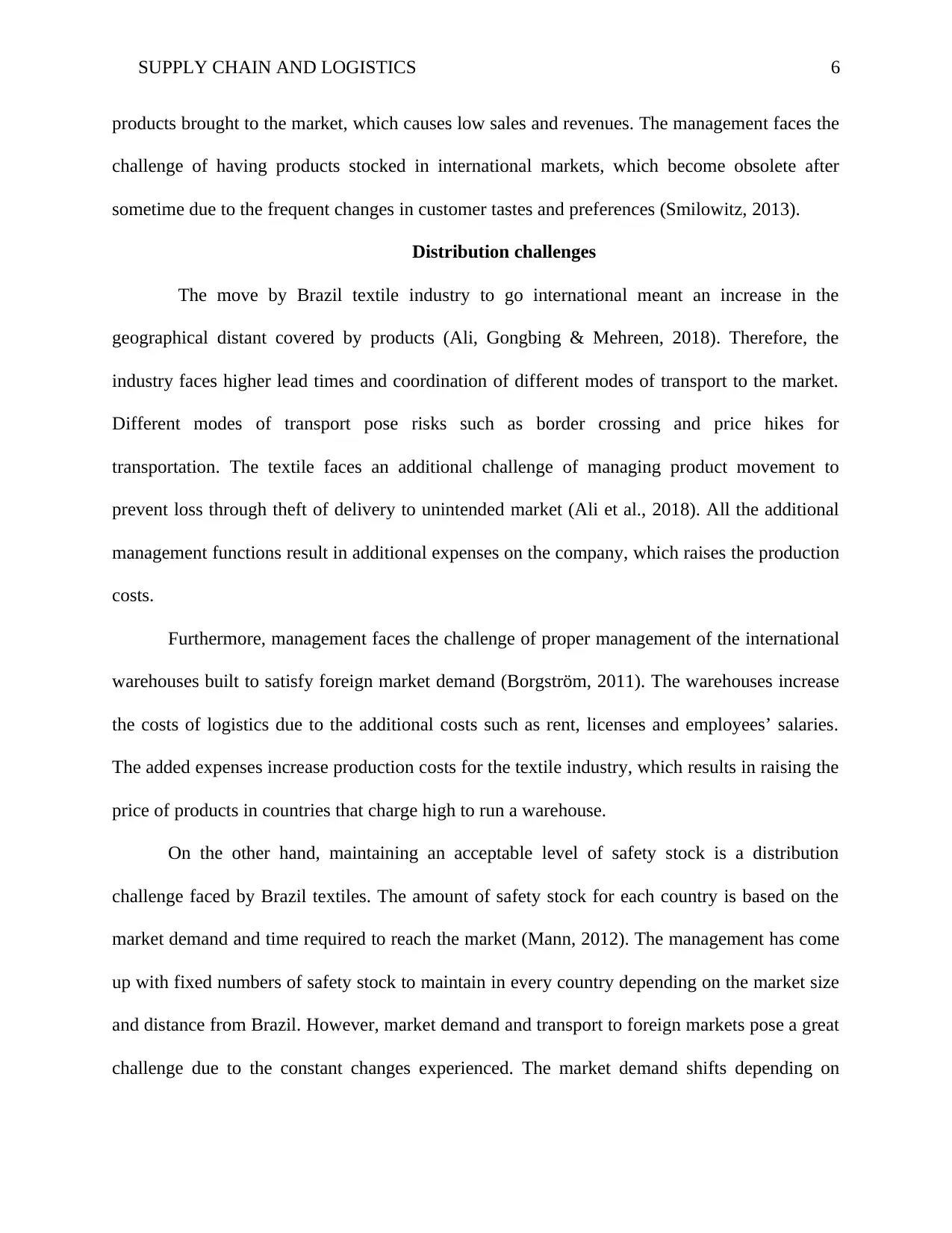
SUPPLY CHAIN AND LOGISTICS 6
products brought to the market, which causes low sales and revenues. The management faces the
challenge of having products stocked in international markets, which become obsolete after
sometime due to the frequent changes in customer tastes and preferences (Smilowitz, 2013).
Distribution challenges
The move by Brazil textile industry to go international meant an increase in the
geographical distant covered by products (Ali, Gongbing & Mehreen, 2018). Therefore, the
industry faces higher lead times and coordination of different modes of transport to the market.
Different modes of transport pose risks such as border crossing and price hikes for
transportation. The textile faces an additional challenge of managing product movement to
prevent loss through theft of delivery to unintended market (Ali et al., 2018). All the additional
management functions result in additional expenses on the company, which raises the production
costs.
Furthermore, management faces the challenge of proper management of the international
warehouses built to satisfy foreign market demand (Borgström, 2011). The warehouses increase
the costs of logistics due to the additional costs such as rent, licenses and employees’ salaries.
The added expenses increase production costs for the textile industry, which results in raising the
price of products in countries that charge high to run a warehouse.
On the other hand, maintaining an acceptable level of safety stock is a distribution
challenge faced by Brazil textiles. The amount of safety stock for each country is based on the
market demand and time required to reach the market (Mann, 2012). The management has come
up with fixed numbers of safety stock to maintain in every country depending on the market size
and distance from Brazil. However, market demand and transport to foreign markets pose a great
challenge due to the constant changes experienced. The market demand shifts depending on
products brought to the market, which causes low sales and revenues. The management faces the
challenge of having products stocked in international markets, which become obsolete after
sometime due to the frequent changes in customer tastes and preferences (Smilowitz, 2013).
Distribution challenges
The move by Brazil textile industry to go international meant an increase in the
geographical distant covered by products (Ali, Gongbing & Mehreen, 2018). Therefore, the
industry faces higher lead times and coordination of different modes of transport to the market.
Different modes of transport pose risks such as border crossing and price hikes for
transportation. The textile faces an additional challenge of managing product movement to
prevent loss through theft of delivery to unintended market (Ali et al., 2018). All the additional
management functions result in additional expenses on the company, which raises the production
costs.
Furthermore, management faces the challenge of proper management of the international
warehouses built to satisfy foreign market demand (Borgström, 2011). The warehouses increase
the costs of logistics due to the additional costs such as rent, licenses and employees’ salaries.
The added expenses increase production costs for the textile industry, which results in raising the
price of products in countries that charge high to run a warehouse.
On the other hand, maintaining an acceptable level of safety stock is a distribution
challenge faced by Brazil textiles. The amount of safety stock for each country is based on the
market demand and time required to reach the market (Mann, 2012). The management has come
up with fixed numbers of safety stock to maintain in every country depending on the market size
and distance from Brazil. However, market demand and transport to foreign markets pose a great
challenge due to the constant changes experienced. The market demand shifts depending on
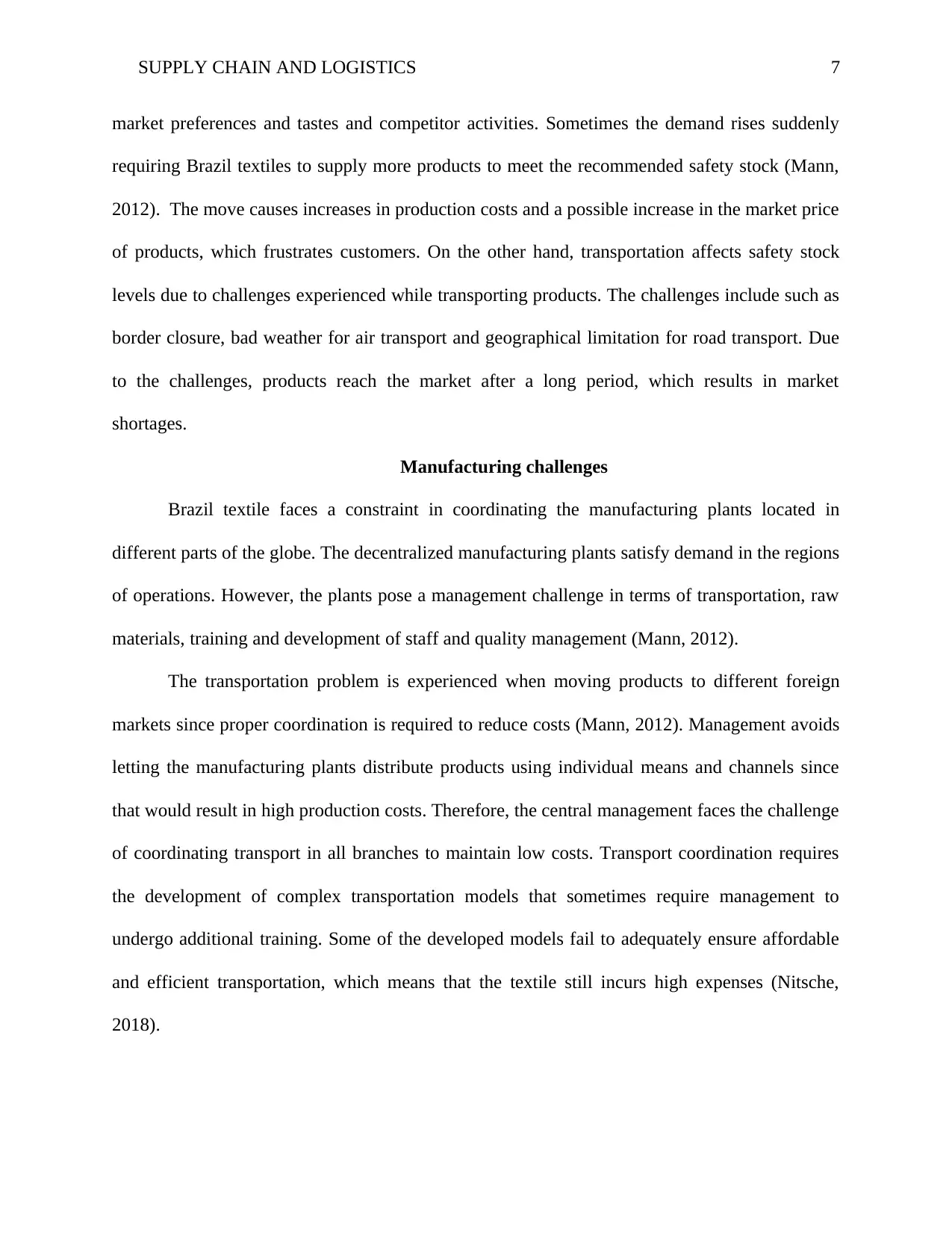
SUPPLY CHAIN AND LOGISTICS 7
market preferences and tastes and competitor activities. Sometimes the demand rises suddenly
requiring Brazil textiles to supply more products to meet the recommended safety stock (Mann,
2012). The move causes increases in production costs and a possible increase in the market price
of products, which frustrates customers. On the other hand, transportation affects safety stock
levels due to challenges experienced while transporting products. The challenges include such as
border closure, bad weather for air transport and geographical limitation for road transport. Due
to the challenges, products reach the market after a long period, which results in market
shortages.
Manufacturing challenges
Brazil textile faces a constraint in coordinating the manufacturing plants located in
different parts of the globe. The decentralized manufacturing plants satisfy demand in the regions
of operations. However, the plants pose a management challenge in terms of transportation, raw
materials, training and development of staff and quality management (Mann, 2012).
The transportation problem is experienced when moving products to different foreign
markets since proper coordination is required to reduce costs (Mann, 2012). Management avoids
letting the manufacturing plants distribute products using individual means and channels since
that would result in high production costs. Therefore, the central management faces the challenge
of coordinating transport in all branches to maintain low costs. Transport coordination requires
the development of complex transportation models that sometimes require management to
undergo additional training. Some of the developed models fail to adequately ensure affordable
and efficient transportation, which means that the textile still incurs high expenses (Nitsche,
2018).
market preferences and tastes and competitor activities. Sometimes the demand rises suddenly
requiring Brazil textiles to supply more products to meet the recommended safety stock (Mann,
2012). The move causes increases in production costs and a possible increase in the market price
of products, which frustrates customers. On the other hand, transportation affects safety stock
levels due to challenges experienced while transporting products. The challenges include such as
border closure, bad weather for air transport and geographical limitation for road transport. Due
to the challenges, products reach the market after a long period, which results in market
shortages.
Manufacturing challenges
Brazil textile faces a constraint in coordinating the manufacturing plants located in
different parts of the globe. The decentralized manufacturing plants satisfy demand in the regions
of operations. However, the plants pose a management challenge in terms of transportation, raw
materials, training and development of staff and quality management (Mann, 2012).
The transportation problem is experienced when moving products to different foreign
markets since proper coordination is required to reduce costs (Mann, 2012). Management avoids
letting the manufacturing plants distribute products using individual means and channels since
that would result in high production costs. Therefore, the central management faces the challenge
of coordinating transport in all branches to maintain low costs. Transport coordination requires
the development of complex transportation models that sometimes require management to
undergo additional training. Some of the developed models fail to adequately ensure affordable
and efficient transportation, which means that the textile still incurs high expenses (Nitsche,
2018).
Paraphrase This Document
Need a fresh take? Get an instant paraphrase of this document with our AI Paraphraser
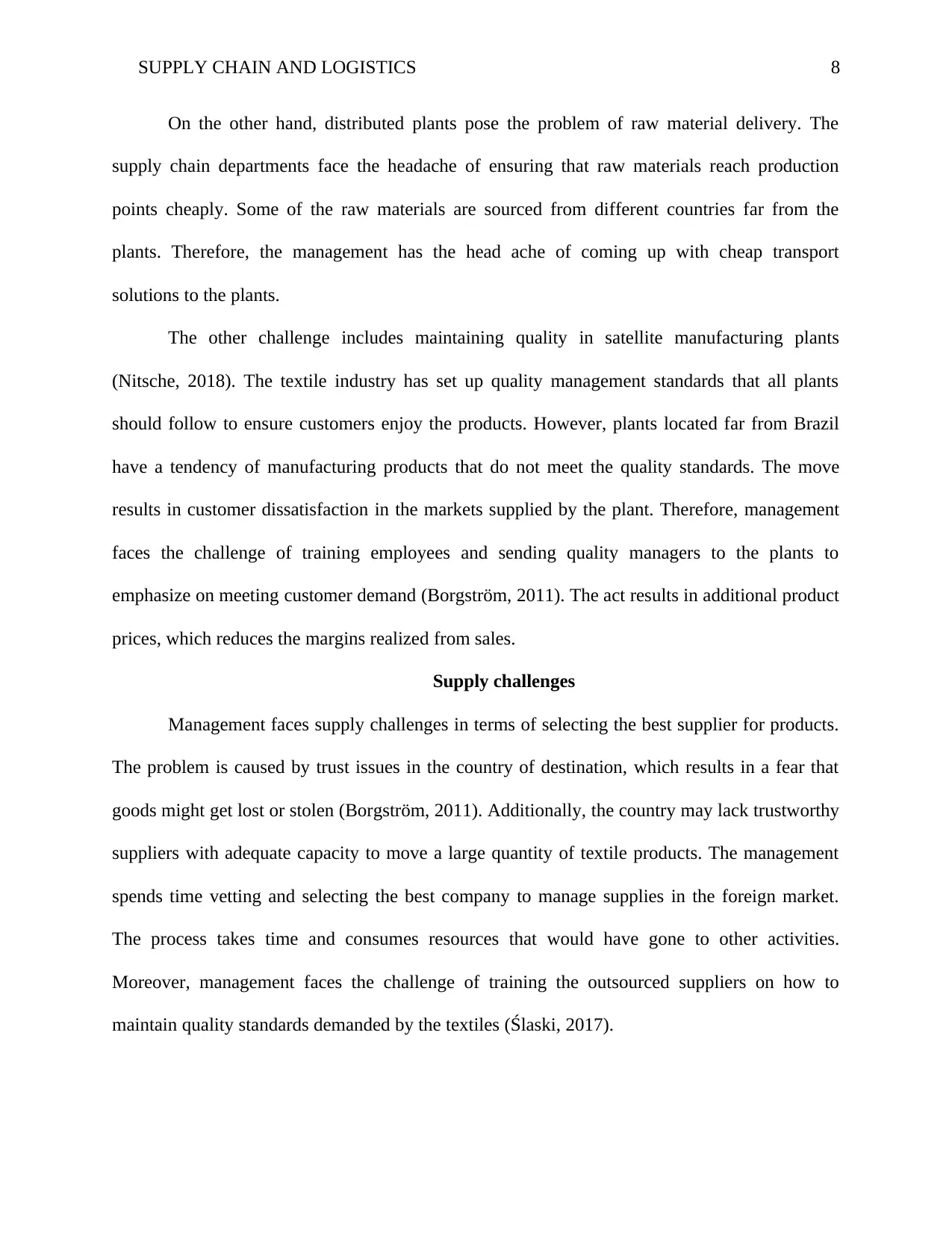
SUPPLY CHAIN AND LOGISTICS 8
On the other hand, distributed plants pose the problem of raw material delivery. The
supply chain departments face the headache of ensuring that raw materials reach production
points cheaply. Some of the raw materials are sourced from different countries far from the
plants. Therefore, the management has the head ache of coming up with cheap transport
solutions to the plants.
The other challenge includes maintaining quality in satellite manufacturing plants
(Nitsche, 2018). The textile industry has set up quality management standards that all plants
should follow to ensure customers enjoy the products. However, plants located far from Brazil
have a tendency of manufacturing products that do not meet the quality standards. The move
results in customer dissatisfaction in the markets supplied by the plant. Therefore, management
faces the challenge of training employees and sending quality managers to the plants to
emphasize on meeting customer demand (Borgström, 2011). The act results in additional product
prices, which reduces the margins realized from sales.
Supply challenges
Management faces supply challenges in terms of selecting the best supplier for products.
The problem is caused by trust issues in the country of destination, which results in a fear that
goods might get lost or stolen (Borgström, 2011). Additionally, the country may lack trustworthy
suppliers with adequate capacity to move a large quantity of textile products. The management
spends time vetting and selecting the best company to manage supplies in the foreign market.
The process takes time and consumes resources that would have gone to other activities.
Moreover, management faces the challenge of training the outsourced suppliers on how to
maintain quality standards demanded by the textiles (Ślaski, 2017).
On the other hand, distributed plants pose the problem of raw material delivery. The
supply chain departments face the headache of ensuring that raw materials reach production
points cheaply. Some of the raw materials are sourced from different countries far from the
plants. Therefore, the management has the head ache of coming up with cheap transport
solutions to the plants.
The other challenge includes maintaining quality in satellite manufacturing plants
(Nitsche, 2018). The textile industry has set up quality management standards that all plants
should follow to ensure customers enjoy the products. However, plants located far from Brazil
have a tendency of manufacturing products that do not meet the quality standards. The move
results in customer dissatisfaction in the markets supplied by the plant. Therefore, management
faces the challenge of training employees and sending quality managers to the plants to
emphasize on meeting customer demand (Borgström, 2011). The act results in additional product
prices, which reduces the margins realized from sales.
Supply challenges
Management faces supply challenges in terms of selecting the best supplier for products.
The problem is caused by trust issues in the country of destination, which results in a fear that
goods might get lost or stolen (Borgström, 2011). Additionally, the country may lack trustworthy
suppliers with adequate capacity to move a large quantity of textile products. The management
spends time vetting and selecting the best company to manage supplies in the foreign market.
The process takes time and consumes resources that would have gone to other activities.
Moreover, management faces the challenge of training the outsourced suppliers on how to
maintain quality standards demanded by the textiles (Ślaski, 2017).
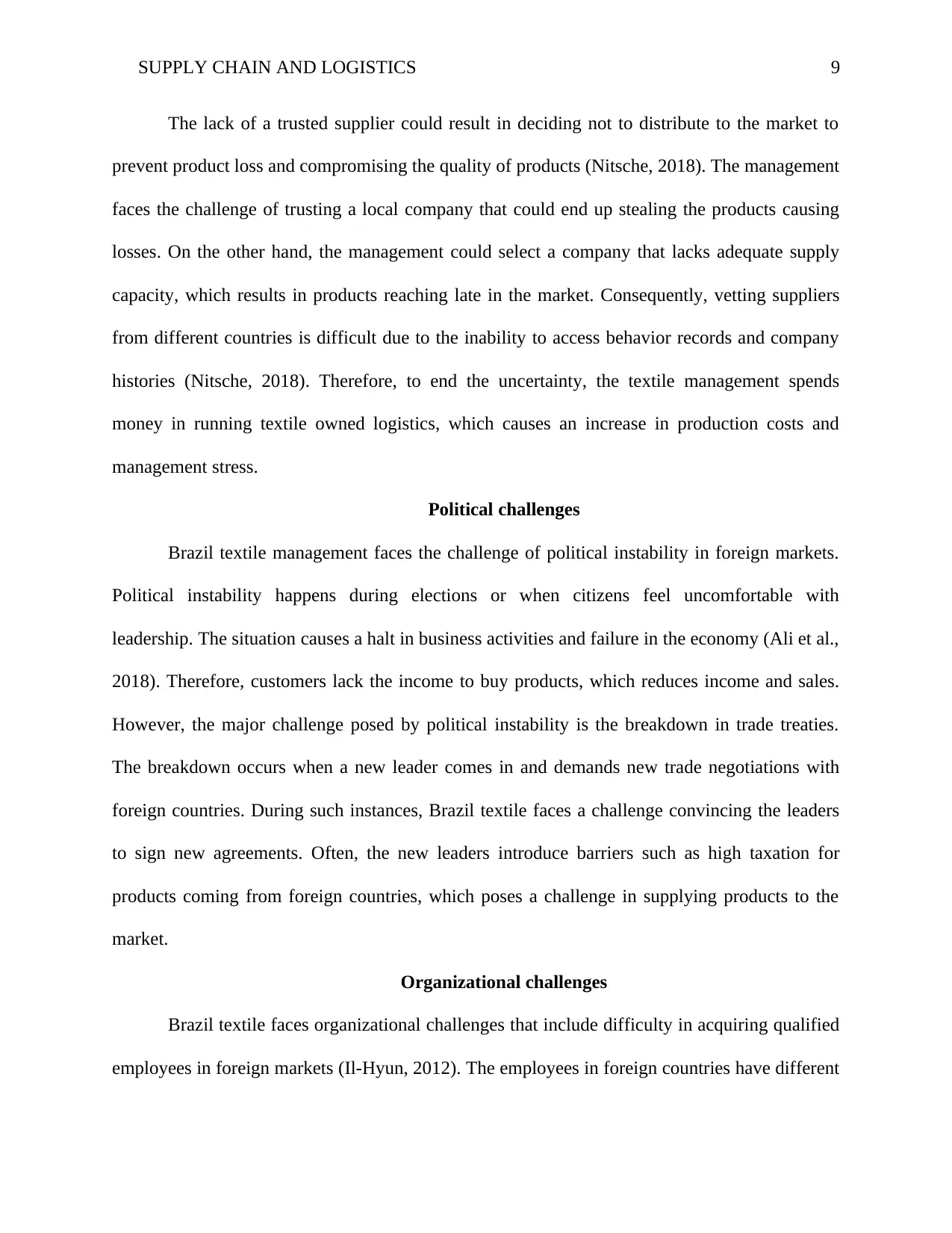
SUPPLY CHAIN AND LOGISTICS 9
The lack of a trusted supplier could result in deciding not to distribute to the market to
prevent product loss and compromising the quality of products (Nitsche, 2018). The management
faces the challenge of trusting a local company that could end up stealing the products causing
losses. On the other hand, the management could select a company that lacks adequate supply
capacity, which results in products reaching late in the market. Consequently, vetting suppliers
from different countries is difficult due to the inability to access behavior records and company
histories (Nitsche, 2018). Therefore, to end the uncertainty, the textile management spends
money in running textile owned logistics, which causes an increase in production costs and
management stress.
Political challenges
Brazil textile management faces the challenge of political instability in foreign markets.
Political instability happens during elections or when citizens feel uncomfortable with
leadership. The situation causes a halt in business activities and failure in the economy (Ali et al.,
2018). Therefore, customers lack the income to buy products, which reduces income and sales.
However, the major challenge posed by political instability is the breakdown in trade treaties.
The breakdown occurs when a new leader comes in and demands new trade negotiations with
foreign countries. During such instances, Brazil textile faces a challenge convincing the leaders
to sign new agreements. Often, the new leaders introduce barriers such as high taxation for
products coming from foreign countries, which poses a challenge in supplying products to the
market.
Organizational challenges
Brazil textile faces organizational challenges that include difficulty in acquiring qualified
employees in foreign markets (Il-Hyun, 2012). The employees in foreign countries have different
The lack of a trusted supplier could result in deciding not to distribute to the market to
prevent product loss and compromising the quality of products (Nitsche, 2018). The management
faces the challenge of trusting a local company that could end up stealing the products causing
losses. On the other hand, the management could select a company that lacks adequate supply
capacity, which results in products reaching late in the market. Consequently, vetting suppliers
from different countries is difficult due to the inability to access behavior records and company
histories (Nitsche, 2018). Therefore, to end the uncertainty, the textile management spends
money in running textile owned logistics, which causes an increase in production costs and
management stress.
Political challenges
Brazil textile management faces the challenge of political instability in foreign markets.
Political instability happens during elections or when citizens feel uncomfortable with
leadership. The situation causes a halt in business activities and failure in the economy (Ali et al.,
2018). Therefore, customers lack the income to buy products, which reduces income and sales.
However, the major challenge posed by political instability is the breakdown in trade treaties.
The breakdown occurs when a new leader comes in and demands new trade negotiations with
foreign countries. During such instances, Brazil textile faces a challenge convincing the leaders
to sign new agreements. Often, the new leaders introduce barriers such as high taxation for
products coming from foreign countries, which poses a challenge in supplying products to the
market.
Organizational challenges
Brazil textile faces organizational challenges that include difficulty in acquiring qualified
employees in foreign markets (Il-Hyun, 2012). The employees in foreign countries have different

SUPPLY CHAIN AND LOGISTICS 10
expertise, which might not suit the requirements of Brazil textiles. Therefore, the textile is forced
to bring employees from Brazil to work and train foreign countries employees. The action is
challenging to the management since moving employees’ results in additional expenses such as
travel allowances, accommodation and salary increments.
Recommendations
Brazil textile should consider various solutions to solve the problems faced in the global
supply chain and logistics. The textiles should consider acquiring private transport resources
such as ship and airplanes for long distance transportation. The move might seem difficult when
considering the purchasing option due to the high prices involved. However, the company could
outsource the means of transport from other companies. The best method of outsourcing the
means of transport is leasing from other companies. Leasing will allow the company to use the
facilities for an agreed period of time without owner interference. Therefore, the company will
have the freedom to transport products to any market without inconveniencing other external
parties.
Moreover, Brazil textiles could enter into strategic alliances with other manufacturing
companies that supply products to international markets. The strategic alliances include
agreements such as transporting products together. Therefore, Brazil textiles will have the chance
to use logistics facilities owned by other companies at a low cost. Additionally, the company will
reduce transport expenses, especially when ferrying few goods with a container. The companies
in the strategic alliances will also put products in the containers and pay part of the cost of
transportation.
Furthermore, Brazil textiles should involve the local textile companies in the foreign
markets in the manufacturing of products. Brazil textile can introduce new designs and
expertise, which might not suit the requirements of Brazil textiles. Therefore, the textile is forced
to bring employees from Brazil to work and train foreign countries employees. The action is
challenging to the management since moving employees’ results in additional expenses such as
travel allowances, accommodation and salary increments.
Recommendations
Brazil textile should consider various solutions to solve the problems faced in the global
supply chain and logistics. The textiles should consider acquiring private transport resources
such as ship and airplanes for long distance transportation. The move might seem difficult when
considering the purchasing option due to the high prices involved. However, the company could
outsource the means of transport from other companies. The best method of outsourcing the
means of transport is leasing from other companies. Leasing will allow the company to use the
facilities for an agreed period of time without owner interference. Therefore, the company will
have the freedom to transport products to any market without inconveniencing other external
parties.
Moreover, Brazil textiles could enter into strategic alliances with other manufacturing
companies that supply products to international markets. The strategic alliances include
agreements such as transporting products together. Therefore, Brazil textiles will have the chance
to use logistics facilities owned by other companies at a low cost. Additionally, the company will
reduce transport expenses, especially when ferrying few goods with a container. The companies
in the strategic alliances will also put products in the containers and pay part of the cost of
transportation.
Furthermore, Brazil textiles should involve the local textile companies in the foreign
markets in the manufacturing of products. Brazil textile can introduce new designs and
Secure Best Marks with AI Grader
Need help grading? Try our AI Grader for instant feedback on your assignments.
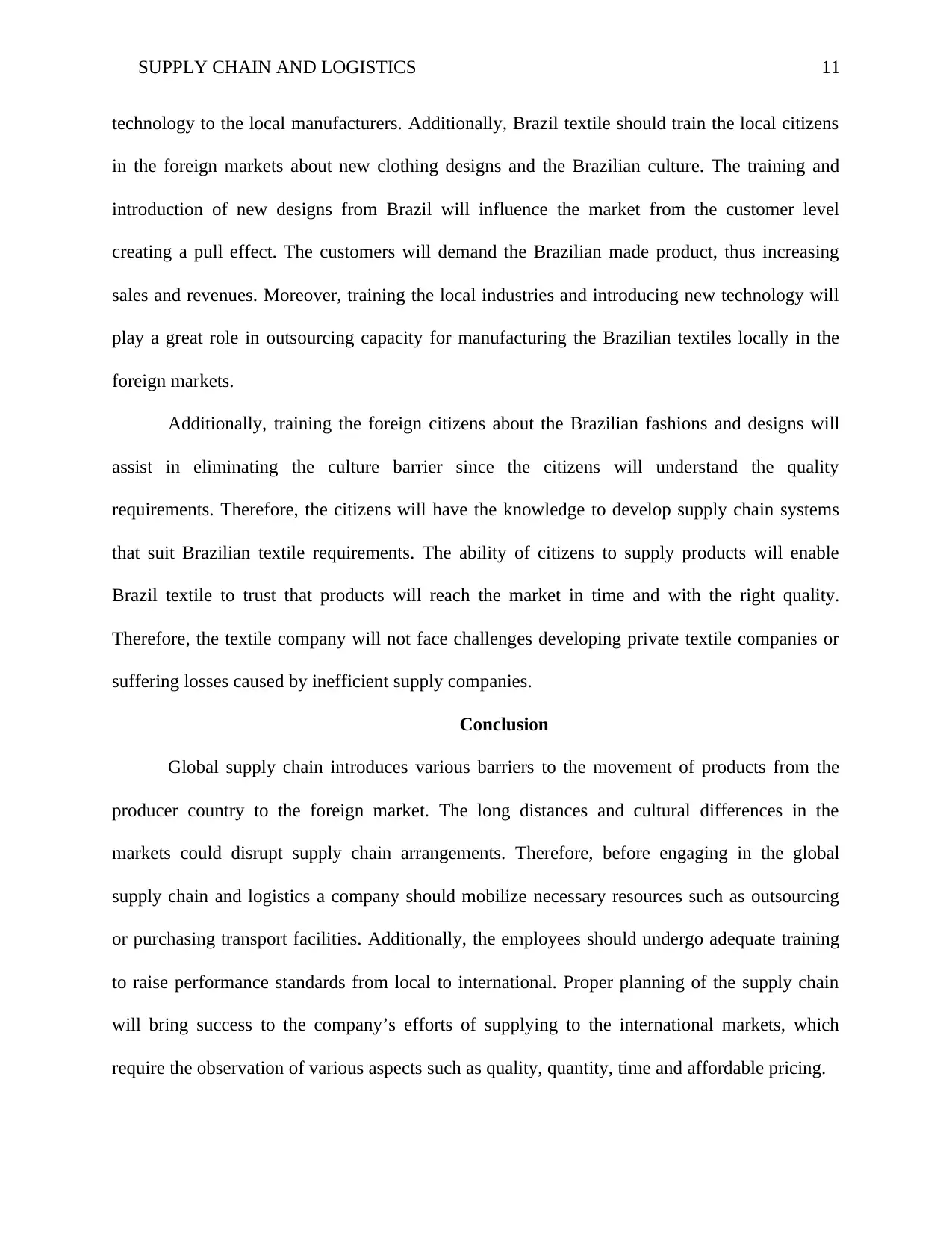
SUPPLY CHAIN AND LOGISTICS 11
technology to the local manufacturers. Additionally, Brazil textile should train the local citizens
in the foreign markets about new clothing designs and the Brazilian culture. The training and
introduction of new designs from Brazil will influence the market from the customer level
creating a pull effect. The customers will demand the Brazilian made product, thus increasing
sales and revenues. Moreover, training the local industries and introducing new technology will
play a great role in outsourcing capacity for manufacturing the Brazilian textiles locally in the
foreign markets.
Additionally, training the foreign citizens about the Brazilian fashions and designs will
assist in eliminating the culture barrier since the citizens will understand the quality
requirements. Therefore, the citizens will have the knowledge to develop supply chain systems
that suit Brazilian textile requirements. The ability of citizens to supply products will enable
Brazil textile to trust that products will reach the market in time and with the right quality.
Therefore, the textile company will not face challenges developing private textile companies or
suffering losses caused by inefficient supply companies.
Conclusion
Global supply chain introduces various barriers to the movement of products from the
producer country to the foreign market. The long distances and cultural differences in the
markets could disrupt supply chain arrangements. Therefore, before engaging in the global
supply chain and logistics a company should mobilize necessary resources such as outsourcing
or purchasing transport facilities. Additionally, the employees should undergo adequate training
to raise performance standards from local to international. Proper planning of the supply chain
will bring success to the company’s efforts of supplying to the international markets, which
require the observation of various aspects such as quality, quantity, time and affordable pricing.
technology to the local manufacturers. Additionally, Brazil textile should train the local citizens
in the foreign markets about new clothing designs and the Brazilian culture. The training and
introduction of new designs from Brazil will influence the market from the customer level
creating a pull effect. The customers will demand the Brazilian made product, thus increasing
sales and revenues. Moreover, training the local industries and introducing new technology will
play a great role in outsourcing capacity for manufacturing the Brazilian textiles locally in the
foreign markets.
Additionally, training the foreign citizens about the Brazilian fashions and designs will
assist in eliminating the culture barrier since the citizens will understand the quality
requirements. Therefore, the citizens will have the knowledge to develop supply chain systems
that suit Brazilian textile requirements. The ability of citizens to supply products will enable
Brazil textile to trust that products will reach the market in time and with the right quality.
Therefore, the textile company will not face challenges developing private textile companies or
suffering losses caused by inefficient supply companies.
Conclusion
Global supply chain introduces various barriers to the movement of products from the
producer country to the foreign market. The long distances and cultural differences in the
markets could disrupt supply chain arrangements. Therefore, before engaging in the global
supply chain and logistics a company should mobilize necessary resources such as outsourcing
or purchasing transport facilities. Additionally, the employees should undergo adequate training
to raise performance standards from local to international. Proper planning of the supply chain
will bring success to the company’s efforts of supplying to the international markets, which
require the observation of various aspects such as quality, quantity, time and affordable pricing.
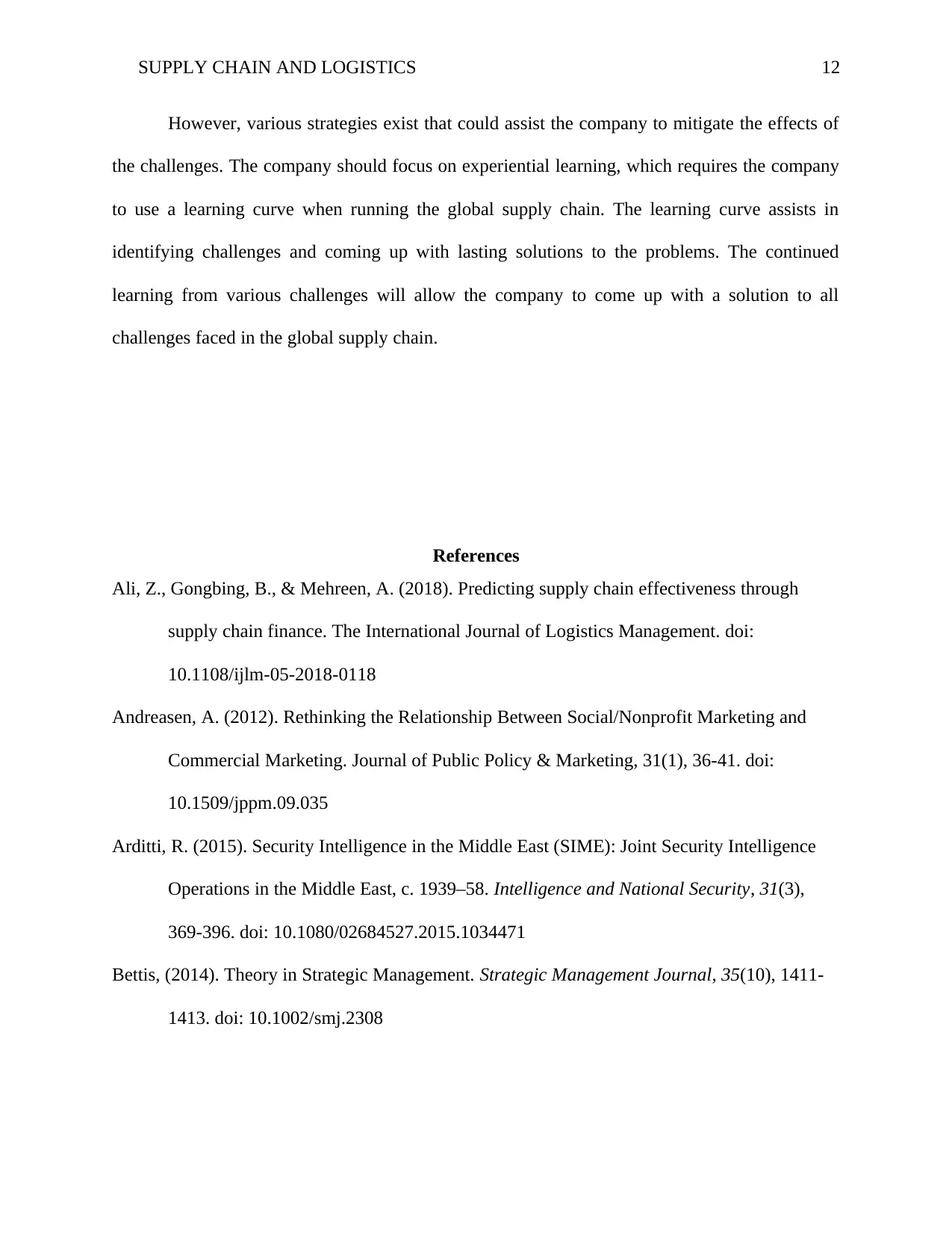
SUPPLY CHAIN AND LOGISTICS 12
However, various strategies exist that could assist the company to mitigate the effects of
the challenges. The company should focus on experiential learning, which requires the company
to use a learning curve when running the global supply chain. The learning curve assists in
identifying challenges and coming up with lasting solutions to the problems. The continued
learning from various challenges will allow the company to come up with a solution to all
challenges faced in the global supply chain.
References
Ali, Z., Gongbing, B., & Mehreen, A. (2018). Predicting supply chain effectiveness through
supply chain finance. The International Journal of Logistics Management. doi:
10.1108/ijlm-05-2018-0118
Andreasen, A. (2012). Rethinking the Relationship Between Social/Nonprofit Marketing and
Commercial Marketing. Journal of Public Policy & Marketing, 31(1), 36-41. doi:
10.1509/jppm.09.035
Arditti, R. (2015). Security Intelligence in the Middle East (SIME): Joint Security Intelligence
Operations in the Middle East, c. 1939–58. Intelligence and National Security, 31(3),
369-396. doi: 10.1080/02684527.2015.1034471
Bettis, (2014). Theory in Strategic Management. Strategic Management Journal, 35(10), 1411-
1413. doi: 10.1002/smj.2308
However, various strategies exist that could assist the company to mitigate the effects of
the challenges. The company should focus on experiential learning, which requires the company
to use a learning curve when running the global supply chain. The learning curve assists in
identifying challenges and coming up with lasting solutions to the problems. The continued
learning from various challenges will allow the company to come up with a solution to all
challenges faced in the global supply chain.
References
Ali, Z., Gongbing, B., & Mehreen, A. (2018). Predicting supply chain effectiveness through
supply chain finance. The International Journal of Logistics Management. doi:
10.1108/ijlm-05-2018-0118
Andreasen, A. (2012). Rethinking the Relationship Between Social/Nonprofit Marketing and
Commercial Marketing. Journal of Public Policy & Marketing, 31(1), 36-41. doi:
10.1509/jppm.09.035
Arditti, R. (2015). Security Intelligence in the Middle East (SIME): Joint Security Intelligence
Operations in the Middle East, c. 1939–58. Intelligence and National Security, 31(3),
369-396. doi: 10.1080/02684527.2015.1034471
Bettis, (2014). Theory in Strategic Management. Strategic Management Journal, 35(10), 1411-
1413. doi: 10.1002/smj.2308

SUPPLY CHAIN AND LOGISTICS 13
Bish, (2012). Comparative Statics Analysis of Multiproduct Newsvendor Networks Under
Responsive Pricing. Operations Research, 60(5), 1111-1124. doi:
10.1287/opre.1120.1097
Borgström, B., (2011). Supply Chain Strategies: Changes in Customer Order-Based Production.
Journal of Business Logistics, 32(4), 361-373. doi: 10.1111/j.0000-0000.2011.01031.x
Essawy, M. (2012). The Implementation of Relationship Marketing by Independent Egyptian
Hotels. Tourism and Hospitality Research, 12(4), 175-187. doi:
10.1177/1467358413477651
Faulkner, P., (2013). Technological Objects, Social Positions, and the Transformational Model
of Social Activity. MIS Quarterly, 37(3), 803-818. doi: 10.25300/misq/2013/37.3.06
Gillingham, P. (2012). The Development of Electronic Information Systems for the Future:
Practitioners, 'Embodied Structures' and 'Technologies-in-Practice'. British Journal of
Social Work, 43(3), 430-445. doi: 10.1093/bjsw/bcr202
Giordani, (2014). Taking the Twists into Account: Predicting Firm Bankruptcy Risk with Splines
of Financial Ratios. Journal of Financial and Quantitative Analysis, 49(04), 1071-1099.
doi: 10.1017/s0022109014000623
Gunasekaran, (2014). Sustainable Operations Management: Design, Modelling and
Analysis. Journal of Operational Research Society, 65(6), 801-805. doi:
10.1057/jors.2014.26
Il-Hyun Jo. (2012). Shared Mental Models on the Performance of E-Learning Content
Development Teams. Journal of Educational Technology & Society, 15(1), 289-297.
Retrieved from http://www.jstor.org/stable/jeductechsoci.15.1.289
Bish, (2012). Comparative Statics Analysis of Multiproduct Newsvendor Networks Under
Responsive Pricing. Operations Research, 60(5), 1111-1124. doi:
10.1287/opre.1120.1097
Borgström, B., (2011). Supply Chain Strategies: Changes in Customer Order-Based Production.
Journal of Business Logistics, 32(4), 361-373. doi: 10.1111/j.0000-0000.2011.01031.x
Essawy, M. (2012). The Implementation of Relationship Marketing by Independent Egyptian
Hotels. Tourism and Hospitality Research, 12(4), 175-187. doi:
10.1177/1467358413477651
Faulkner, P., (2013). Technological Objects, Social Positions, and the Transformational Model
of Social Activity. MIS Quarterly, 37(3), 803-818. doi: 10.25300/misq/2013/37.3.06
Gillingham, P. (2012). The Development of Electronic Information Systems for the Future:
Practitioners, 'Embodied Structures' and 'Technologies-in-Practice'. British Journal of
Social Work, 43(3), 430-445. doi: 10.1093/bjsw/bcr202
Giordani, (2014). Taking the Twists into Account: Predicting Firm Bankruptcy Risk with Splines
of Financial Ratios. Journal of Financial and Quantitative Analysis, 49(04), 1071-1099.
doi: 10.1017/s0022109014000623
Gunasekaran, (2014). Sustainable Operations Management: Design, Modelling and
Analysis. Journal of Operational Research Society, 65(6), 801-805. doi:
10.1057/jors.2014.26
Il-Hyun Jo. (2012). Shared Mental Models on the Performance of E-Learning Content
Development Teams. Journal of Educational Technology & Society, 15(1), 289-297.
Retrieved from http://www.jstor.org/stable/jeductechsoci.15.1.289
Paraphrase This Document
Need a fresh take? Get an instant paraphrase of this document with our AI Paraphraser
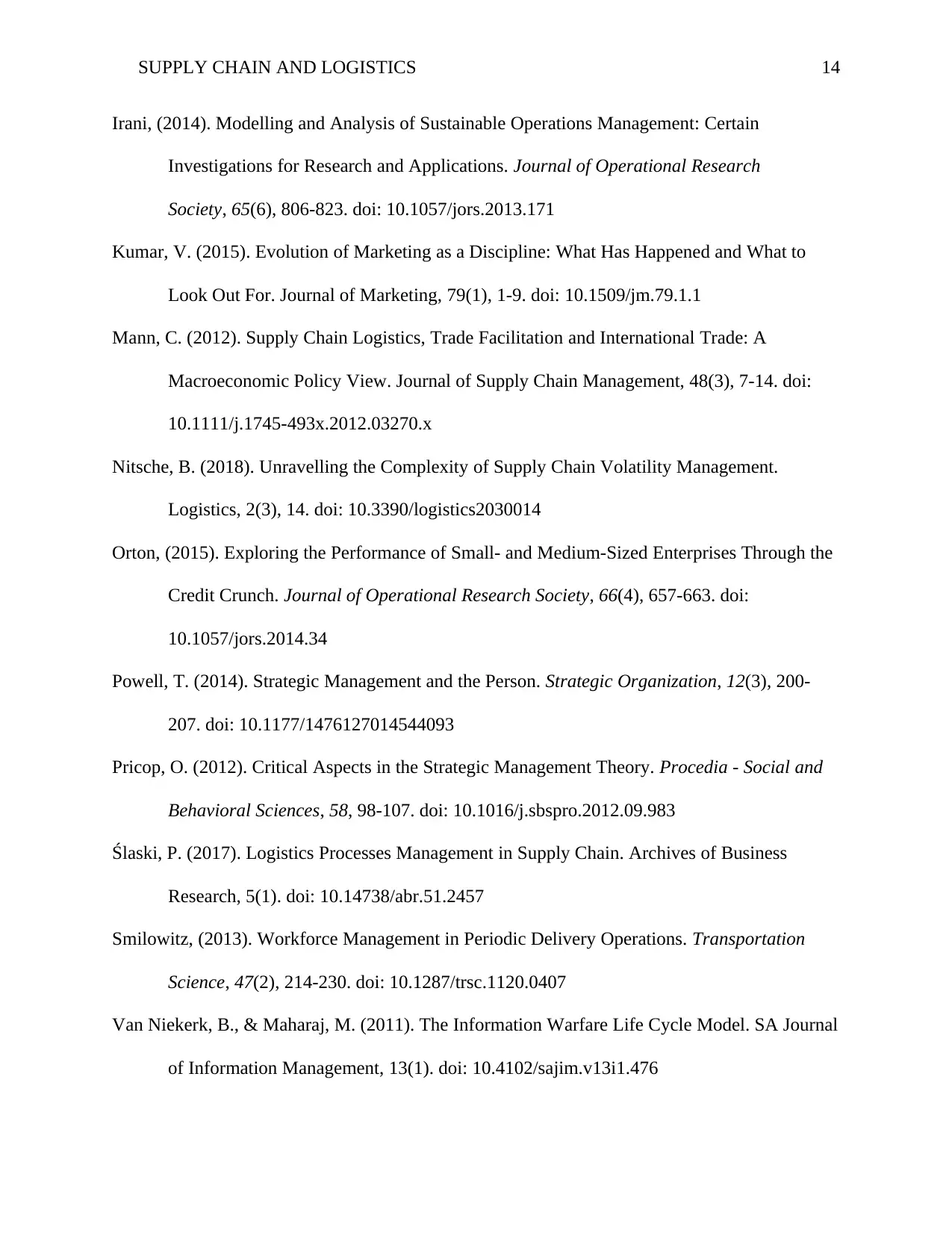
SUPPLY CHAIN AND LOGISTICS 14
Irani, (2014). Modelling and Analysis of Sustainable Operations Management: Certain
Investigations for Research and Applications. Journal of Operational Research
Society, 65(6), 806-823. doi: 10.1057/jors.2013.171
Kumar, V. (2015). Evolution of Marketing as a Discipline: What Has Happened and What to
Look Out For. Journal of Marketing, 79(1), 1-9. doi: 10.1509/jm.79.1.1
Mann, C. (2012). Supply Chain Logistics, Trade Facilitation and International Trade: A
Macroeconomic Policy View. Journal of Supply Chain Management, 48(3), 7-14. doi:
10.1111/j.1745-493x.2012.03270.x
Nitsche, B. (2018). Unravelling the Complexity of Supply Chain Volatility Management.
Logistics, 2(3), 14. doi: 10.3390/logistics2030014
Orton, (2015). Exploring the Performance of Small- and Medium-Sized Enterprises Through the
Credit Crunch. Journal of Operational Research Society, 66(4), 657-663. doi:
10.1057/jors.2014.34
Powell, T. (2014). Strategic Management and the Person. Strategic Organization, 12(3), 200-
207. doi: 10.1177/1476127014544093
Pricop, O. (2012). Critical Aspects in the Strategic Management Theory. Procedia - Social and
Behavioral Sciences, 58, 98-107. doi: 10.1016/j.sbspro.2012.09.983
Ślaski, P. (2017). Logistics Processes Management in Supply Chain. Archives of Business
Research, 5(1). doi: 10.14738/abr.51.2457
Smilowitz, (2013). Workforce Management in Periodic Delivery Operations. Transportation
Science, 47(2), 214-230. doi: 10.1287/trsc.1120.0407
Van Niekerk, B., & Maharaj, M. (2011). The Information Warfare Life Cycle Model. SA Journal
of Information Management, 13(1). doi: 10.4102/sajim.v13i1.476
Irani, (2014). Modelling and Analysis of Sustainable Operations Management: Certain
Investigations for Research and Applications. Journal of Operational Research
Society, 65(6), 806-823. doi: 10.1057/jors.2013.171
Kumar, V. (2015). Evolution of Marketing as a Discipline: What Has Happened and What to
Look Out For. Journal of Marketing, 79(1), 1-9. doi: 10.1509/jm.79.1.1
Mann, C. (2012). Supply Chain Logistics, Trade Facilitation and International Trade: A
Macroeconomic Policy View. Journal of Supply Chain Management, 48(3), 7-14. doi:
10.1111/j.1745-493x.2012.03270.x
Nitsche, B. (2018). Unravelling the Complexity of Supply Chain Volatility Management.
Logistics, 2(3), 14. doi: 10.3390/logistics2030014
Orton, (2015). Exploring the Performance of Small- and Medium-Sized Enterprises Through the
Credit Crunch. Journal of Operational Research Society, 66(4), 657-663. doi:
10.1057/jors.2014.34
Powell, T. (2014). Strategic Management and the Person. Strategic Organization, 12(3), 200-
207. doi: 10.1177/1476127014544093
Pricop, O. (2012). Critical Aspects in the Strategic Management Theory. Procedia - Social and
Behavioral Sciences, 58, 98-107. doi: 10.1016/j.sbspro.2012.09.983
Ślaski, P. (2017). Logistics Processes Management in Supply Chain. Archives of Business
Research, 5(1). doi: 10.14738/abr.51.2457
Smilowitz, (2013). Workforce Management in Periodic Delivery Operations. Transportation
Science, 47(2), 214-230. doi: 10.1287/trsc.1120.0407
Van Niekerk, B., & Maharaj, M. (2011). The Information Warfare Life Cycle Model. SA Journal
of Information Management, 13(1). doi: 10.4102/sajim.v13i1.476
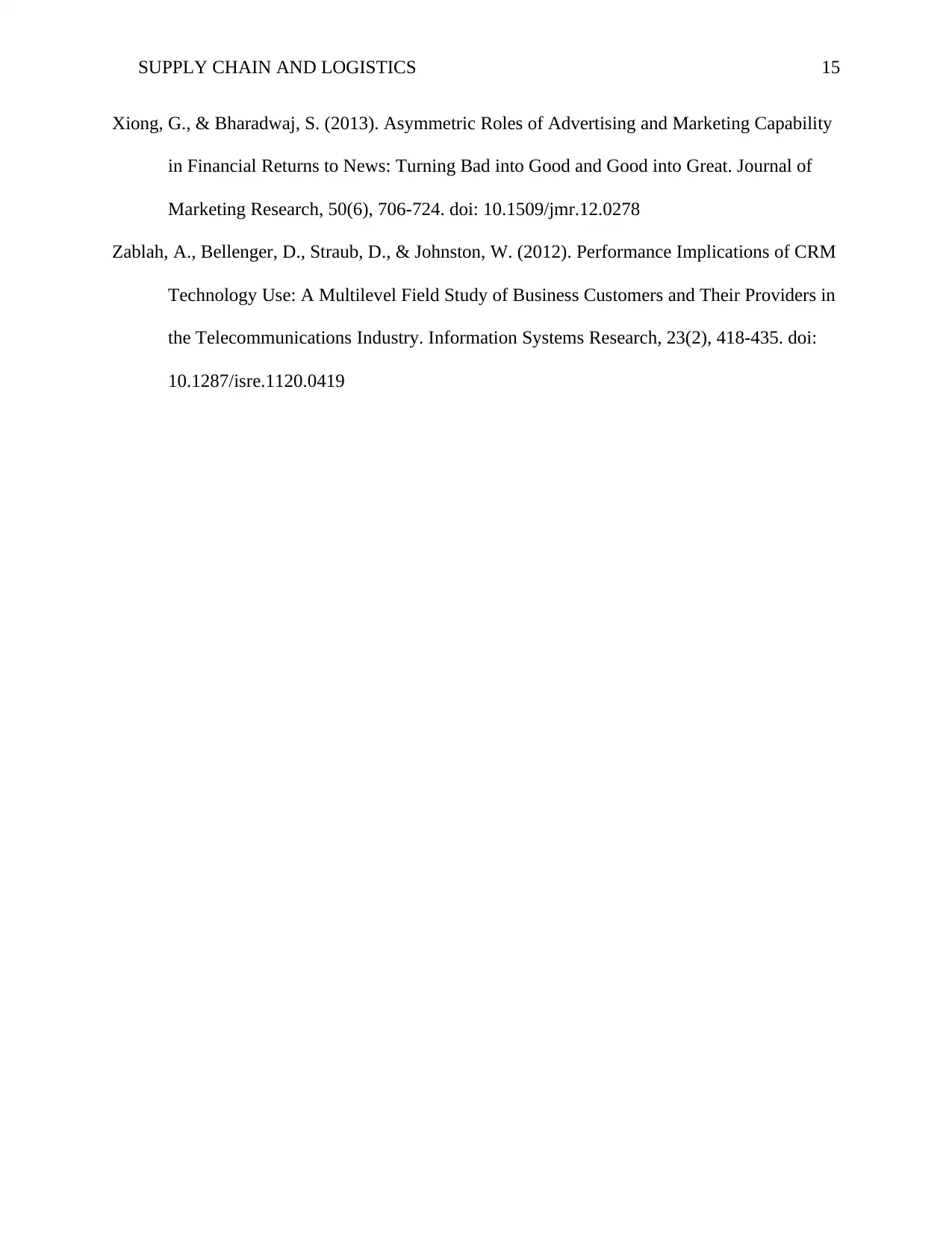
SUPPLY CHAIN AND LOGISTICS 15
Xiong, G., & Bharadwaj, S. (2013). Asymmetric Roles of Advertising and Marketing Capability
in Financial Returns to News: Turning Bad into Good and Good into Great. Journal of
Marketing Research, 50(6), 706-724. doi: 10.1509/jmr.12.0278
Zablah, A., Bellenger, D., Straub, D., & Johnston, W. (2012). Performance Implications of CRM
Technology Use: A Multilevel Field Study of Business Customers and Their Providers in
the Telecommunications Industry. Information Systems Research, 23(2), 418-435. doi:
10.1287/isre.1120.0419
Xiong, G., & Bharadwaj, S. (2013). Asymmetric Roles of Advertising and Marketing Capability
in Financial Returns to News: Turning Bad into Good and Good into Great. Journal of
Marketing Research, 50(6), 706-724. doi: 10.1509/jmr.12.0278
Zablah, A., Bellenger, D., Straub, D., & Johnston, W. (2012). Performance Implications of CRM
Technology Use: A Multilevel Field Study of Business Customers and Their Providers in
the Telecommunications Industry. Information Systems Research, 23(2), 418-435. doi:
10.1287/isre.1120.0419
1 out of 15
Related Documents
Your All-in-One AI-Powered Toolkit for Academic Success.
+13062052269
info@desklib.com
Available 24*7 on WhatsApp / Email
![[object Object]](/_next/static/media/star-bottom.7253800d.svg)
Unlock your academic potential
© 2024 | Zucol Services PVT LTD | All rights reserved.




